The AMD Trinity Review (A10-4600M): A New Hope
by Jarred Walton on May 15, 2012 12:00 AM ESTAMD Trinity General Performance
Starting as usual with our general performance assessment, we’ve got several Futuremark benchmarks along with Cinebench and x264 HD encoding. The latter two focus specifically on stressing the CPU while PCMarks will cover most areas of system performance (including a large emphasis on storage) and 3DMarks will give us a hint at graphics performance. First up, PCMark 7 and Vantage:
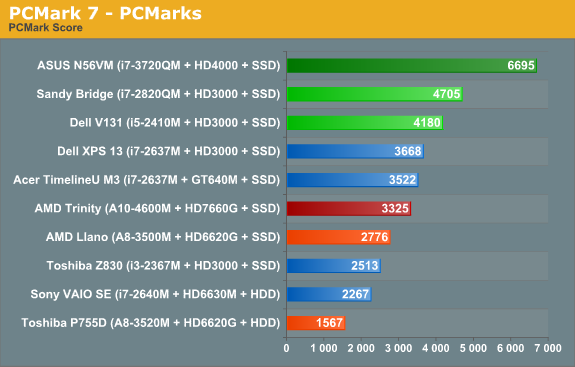
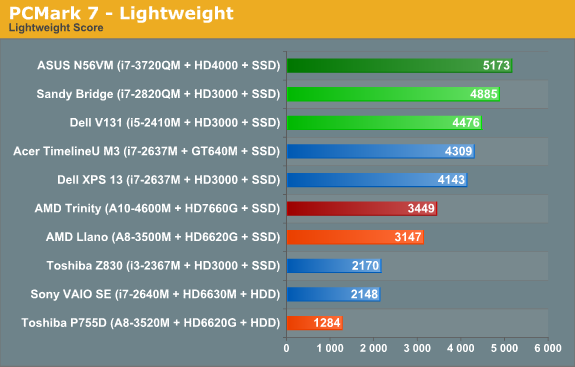
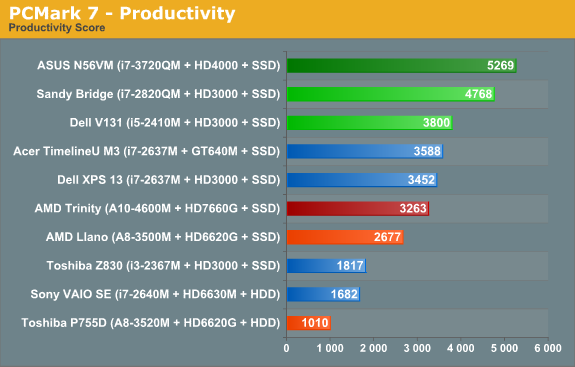

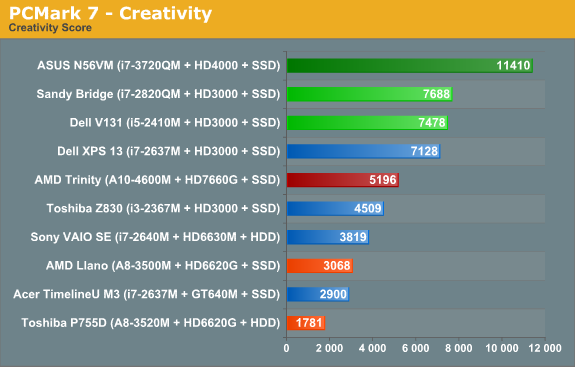
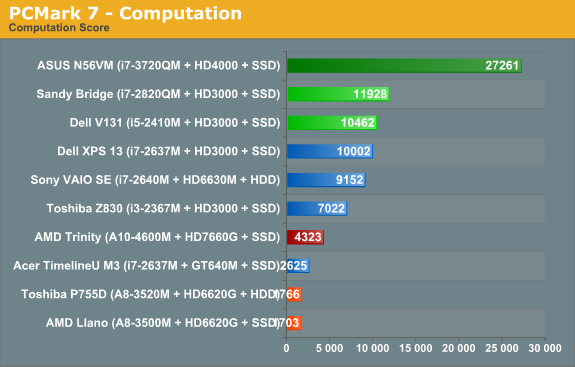
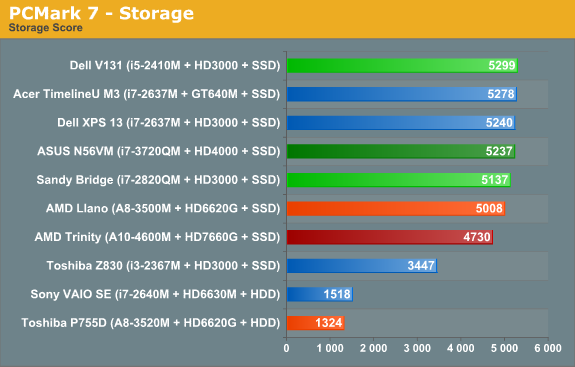
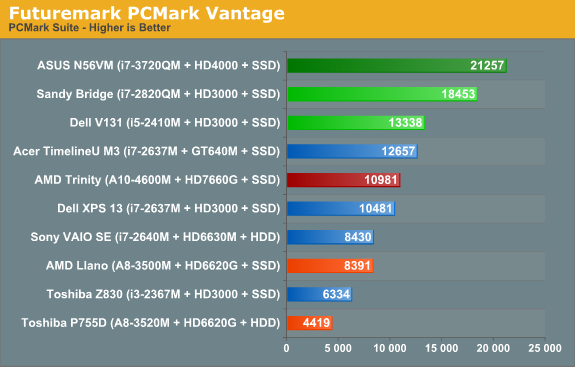
As noted earlier, we ran several other laptops through PCMark 7 and PCMark Vantage testing using the same Intel 520 240GB SSD, plus all the ultrabooks come with SSDs. That removes the SSD as a factor from most of the PCMark comparisons, leaving the rest of the platform to sink or swim on its own. And just how does AMD Trinity do here? Honestly, it’s not too bad, despite positioning within the charts.
Obviously, Intel’s quad-core Ivy Bridge is a beast when it comes to performance, but it’s a 45W beast that costs over $300 just for the CPU. We’ll have to wait for dual-core Ivy Bridge to see exactly how Intel’s latest stacks up against AMD, but if you remember the Llano vs. Sandy Bridge comparisons it looks like we’re in for more of the same. Intel continues to offer superior CPU performance, and even their Sandy Bridge ULV processors can often surpass Llano and Trinity. In the overall PCMark 7 metric, Trinity ends up being 20% faster than a Llano A8-3500M laptop, while Intel’s midrange i5-2410M posts a similar 25% lead on Trinity. Outside of the SSD, we’d expect Trinity and the Vostro V131 to both sell for around $600 as equipped.
A 25% lead for Intel is pretty big, but what you don’t necessarily get from the charts is that for many users, it just doesn’t matter. I know plenty of people using older Core 2 Duo (and even a few Core Duo!) laptops, and for general office tasks and Internet surfing they’re fine. Llano was already faster in general use than Core 2 Duo and Athlon X2 class hardware, and it delivered great battery life. Trinity boosts performance and [spoiler alert!] battery life, so it’s a net win. If you’re looking for a mobile workstation or something to do some hardcore gaming, Trinity won’t cut it—you’d want a quad-core Intel CPU for the former, and something with a discrete GPU for the latter—but for everything else, we’re in the very broad category known as “good enough”.


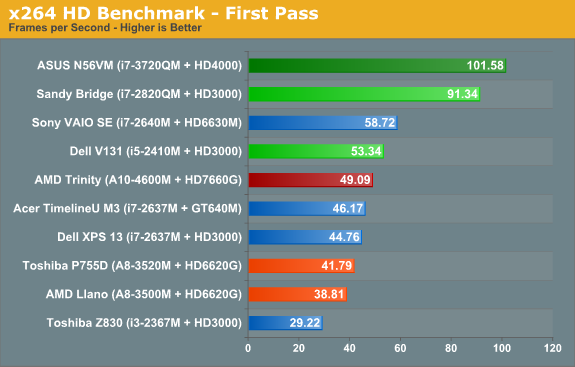
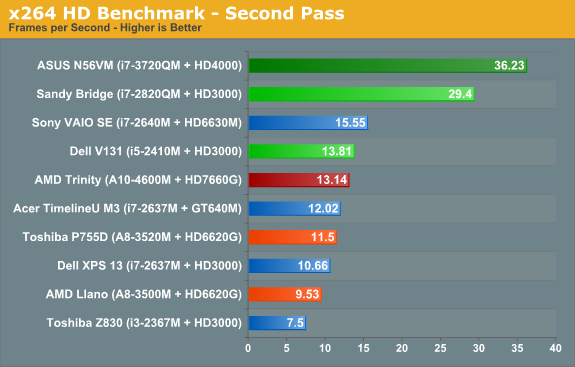
When we start drilling down into other performance metrics, AMD’s CPU performance deficiency becomes pretty obvious. The Cinebench single-threaded score is up 15% from 35W Llano, but in a bit of a surprise the multi-threaded score is basically a wash. Turn to the x264 HD encoding test however and Trinity once again shows a decent 15% improvement over Llano. Against Sandy Bridge and Ivy Bridge, though? AMD’s Trinity doesn’t stand a chance: i5-2410M is 50% faster in single-threaded Cinebench, 27% faster in multi-threaded, and 5-10% faster in x264. It’s a good thing 99.99% of laptop users never actually run applications like Cinebench for “real work”, but if you want to do video encoding a 10% increase can be very noticeable.

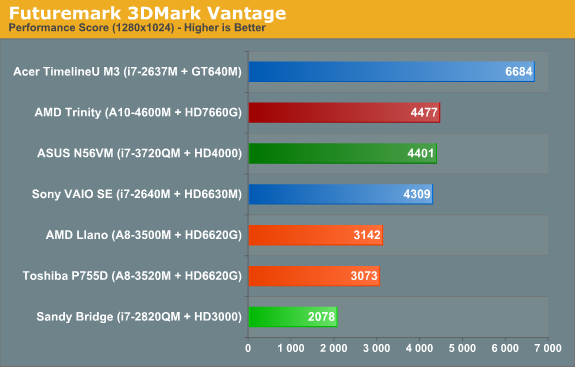
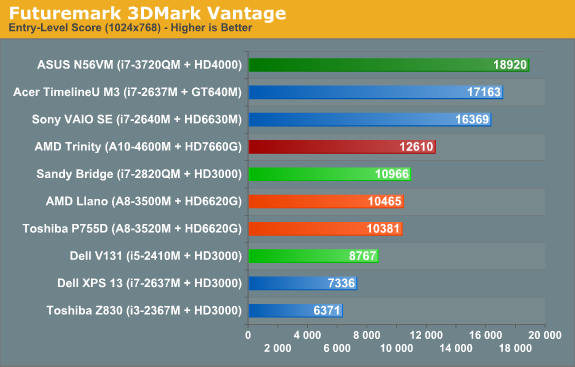
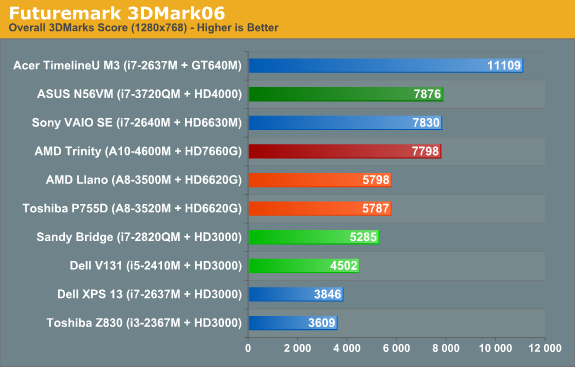
Shift over to graphics oriented benchmarks and the tables turn once again...sort of. Sandy Bridge can’t run 3DMark11, since it only has a DX10 class GPU, but in Vantage Performance and 3DMark06 Trinity is more than twice as fast as HD 3000. Of course, Ivy Bridge’s HD 4000 is the new Intel IGP Sheriff around these parts, and interestingly we see Trinity and i7-3720QM basically tied in these two synthetics. (We’ll just ignore 3DMark Vantage’s Entry benchmark, as it’s so light on graphics quality that we’ve found it doesn’t really stress most GPUs much—even low-end GPUs like HD 3000 score quite well.) We’ll dig into graphics performance more with our gaming benchmarks next.










271 Comments
View All Comments
medi01 - Thursday, May 17, 2012 - link
Half of CPU performance, but better GPU performance and power consumption.And I doubt that for an average consumer the first matters more than the latter.
wsaenotsock - Tuesday, May 15, 2012 - link
I mean to summarize all of this, it's a low performance processor with average graphics performance (comparing to an i7 and a discrete GPU), with above average battery life. I think with the right pricing AMD can put out a great rounded mobile product. The best thing it has going for it needs to be the price since it doesn't really lead the pack in any other area. I bought a Zacate netbook and I found it very useful for the price.I wonder if a few generations from now, AMD can begin to outperform CPU + discrete GPU's with it's combined APU chips, or at least on a per-watt basis really deliver uncomparable performance. That would really make the AMD fusion platform a new beast but it doesn't seem ready for that yet. Still it must be a goal for AMD and it is really one that will become more important as time goes on with computing solutions miniaturizing every year.
Denithor - Tuesday, May 15, 2012 - link
They won't ever surpass CPU + discrete GPU for one simple reason: TDP.You simply cannot match the performance of a 75-100W CPU + 100-200W GPU with a 75-100W APU.
Kaggy - Tuesday, May 15, 2012 - link
Any chance of Windows 8 comparison someday, just curious.Kaggy - Tuesday, May 15, 2012 - link
i meant processor comparison on windows 8EyelessBlond - Tuesday, May 15, 2012 - link
I'm wondering how the memory clocks are affecting Trinity performance. We saw with Llano that the processor was memory constrained, such that you saw a significant improvement with DDR3 1866 as opposed to DDR3 1600; now that the chip is shuffling bits even faster I'm curious to see if more memory throughput (triple channel DDR3, the new DDR4, or even a relatively simple memory overclock) can boost APU performance even more with these new chips.JarredWalton - Tuesday, May 15, 2012 - link
Officially, mobile Trinity only supports up to DDR3-1600, which is what we have for testing. The clocks on the desktop version will likely be higher, making more bandwidth potentially useful, but unfortunately we can't test anything higher than DDR3-1600 on Trinity. And as an aside, I tried using DDR3-1600 with the Llano laptop, only to find that the BIOS won't allow anything higher than DDR3-1333 speeds. I wouldn't be surprised if this prototype Trinity laptop is the same way with regards to RAM speeds -- the BIOS on this sort of laptop is always pretty bare.Khato - Tuesday, May 15, 2012 - link
Does the prototype Trinity laptop BIOS support running the memory at DDR3-1333? That would at least offer an indication of whether certain benchmarks are memory bandwidth limited or not which would then imply whether or not higher memory frequency actually would help. Would also be interesting to see performance with just single channel memory seeing as how all too many manufacturers are still shipping laptops with that configuration.JarredWalton - Tuesday, May 15, 2012 - link
I don't think so, but I can always stick in DDR3-1333 RAM if needed. Might be interesting, but you'll have to wait a day or two for me to get something like that tested.Khato - Tuesday, May 15, 2012 - link
Good idea, so long as it doesn't either overclock the memory to 1600 anyway or simply refuse to boot, haha. Hopefully it'll work though since I'm quite curious to see the results! It'll not only give us an idea of whether higher speed memory will help, but also how much of a hit the lesser versions of the iGPU on the other SKUs will take.